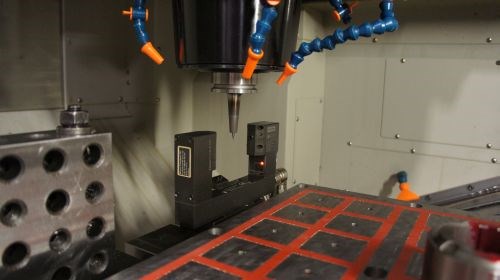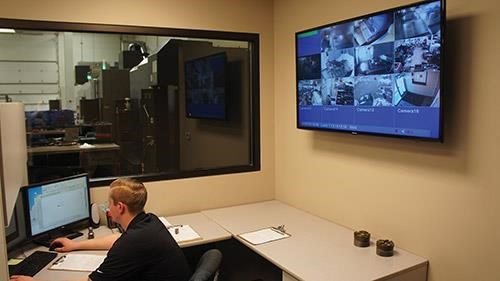Broken-Up Programs Limit Broken Tools
Posting tool paths for different operations to the machine individually rather than as a single, combined part program helps this heavily lights-out operation quickly address the causes of tool wear and breakage.
Share





Breaking up programs by operation speeds the process of troubleshooting a worn or broken tool after an alarm is triggered by a Blum laser tool probe, an accessory common to all of the shop’s machining centers.
Thanks to workzone-mounted cameras and other remote machine monitoring and control technology, personnel at Hard Milling Solutions (HMS) can respond immediately to any problems during the shop’s two lights-out shifts. However, determining the source of the problem when a machine’s laser tool probe triggers an alarm for wear or breakage can still take a great deal of time. In these instances, the shop relies on another strategy to get spindles spinning again as quickly as possible, one that’s exceedingly simple to execute. That is, to segment part programs by posting tool paths for different operations separately, rather than as a package.

Even during the single, staffed shift, the shop floor at HMS can be a lonely place. Programmers like Ryan Mihelcich, shown here, rely on video feeds and automatic alerts to keep them apprised of ongoing machining operations while they program future jobs. In fact, one such alert is tied into the shop’s doorbell, which rings whenever a machine stops.
The essential idea is that determining why a one-hour program alarmed out is far easier than determining why a 10-hour program alarmed out, says Corey Greenwald, HMS founder and president. That’s because after an alarm, the program essentially “rewinds,” he explains. So, the process of discovering when a problem occurred (let alone why) requires retracing steps, sometimes all the way back to the first toolpath. Even if the 10-hour program calls for hourly checks for tool wear or breakage with an integrated laser probe, the only benefit of an alarm is ensuring that the machine shuts down and that the problem doesn’t get any worse. Posting the program in hourly segments instead, with a laser check after each, makes troubleshooting faster by isolating the portion of the machining routine where the error occurred.
In some cases, a simple visual check of the part might be enough to determine which operations completed before the alarm. However, HMS’s mostly mold and die industry work, which often involves taking multiple, light passes across the same complex geometry, makes these visual checks less reliable than they might sound, Mr. Greenwald says. “If you’re squeezing down into a tight crevice, it can be hard to see with the human eye whether you've got a 6-ball (6-mm ballnose end mill) or a 3-ball in there,” he explains. He adds that segmented programs come in particularly handy when multiple operations use the same cutting tool, particularly when those operations don’t occur in sequence. “With one big program that’s errored out, all you’ll know is which tool is in the spindle.”
Although this concept is straightforward, it might not work for every shop. HMS has standardized largely on Makino, which supplied seven of the shop’s eight high-speed, hard-milling VMCs. That builder’s Professional 5 CNC offers two capabilities that facilitate HMS’s segmented programming approach. One is the capability to customize program names. This helps employees understand what’s happening during a particular portion of the machining routine, and Mr. Greenwald says it comes in particularly handy when multiple, non-sequential operations employ the same cutter (examples of typical names for HMS program segments include “10-mm rough” and “6-mm semi-finish”). Perhaps more importantly, the CNC enables running multiple programs in sequence, and that list can be displayed in the DNC list. “You could write a macro to list the operations with other controls, but when it errors out, it’ll just rewind to the beginning. With the Pro 5, it’s easy to have a list of every program that’s going to run, and they’ll run one after the other. If there’s an alarm, the program segment where it occurred will show up as incomplete.”
Segmented programming certainly comes in handy, but this is a shop that thrives largely on ensuring tools don’t break or wear prematurely in the first place. For an operation focused so heavily on unattended machining, process reliability and predictability are paramount. Although far more involved than segmented programming, HMS’s approach to ensuring that reliability and predictability is rooted in very simple concepts. Essentially, the shop makes the most of its CAM software tool library by painstakingly tracking machining parameters for every job, then standardizing on the most effective settings for particular combinations of cutting tools and materials. This March-issue feature article tells that story.
Related Content
4 Commonly Misapplied CNC Features
Misapplication of these important CNC features will result in wasted time, wasted or duplicated effort and/or wasted material.
Read MoreTips for Designing CNC Programs That Help Operators
The way a G-code program is formatted directly affects the productivity of the CNC people who use them. Design CNC programs that make CNC setup people and operators’ jobs easier.
Read MoreERP Provides Smooth Pathway to Data Security
With the CMMC data security standards looming, machine shops serving the defense industry can turn to ERP to keep business moving.
Read MoreOrthopedic Event Discusses Manufacturing Strategies
At the seminar, representatives from multiple companies discussed strategies for making orthopedic devices accurately and efficiently.
Read MoreRead Next
Setting Up the Building Blocks for a Digital Factory
Woodward Inc. spent over a year developing an API to connect machines to its digital factory. Caron Engineering’s MiConnect has cut most of this process while also granting the shop greater access to machine information.
Read MoreRegistration Now Open for the Precision Machining Technology Show (PMTS) 2025
The precision machining industry’s premier event returns to Cleveland, OH, April 1-3.
Read MoreBuilding Out a Foundation for Student Machinists
Autodesk and Haas have teamed up to produce an introductory course for students that covers the basics of CAD, CAM and CNC while providing them with a portfolio part.
Read More































